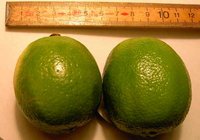This is a shrubby tree, to 5 m (16 ft). The trunk rarely grows straight, with many branches that often originate quite far down on the trunk. The leaves are ovate 2.5–9 cm (1–3.5 in) long, resembling orange leaves (the scientific name aurantifolia refers to the leaves' resemblance). The flowers are 2.5 cm (1 in) in diameter, are yellowish white with a light purple tinge on the margins. Flowers and fruit appear throughout the year but are most abundant from May to September.
Limes are oval or globose bright green fruit with a sour, pungent flavor. If they stay on the tree for a long time they turn yellow and resemble a small roundish lemon. Lime juice is used in cooking and in soft drinks, and limeade (like lemonade). Alcoholic drinks closely associated with the lime include cocktails such as the mojito, the Mexican beer Corona, and many varieties of tequila. Some like to eat them as fruits, as did British sailors. Miniature limes are commonly referred to as cocktail limes. Lime extracts and essential oils are frequently used in perfumes, cleansing products, and for aromatherapy.
For other meanings of the word lime, see Lime.
| Lime | ||||||||||||||||
|---|---|---|---|---|---|---|---|---|---|---|---|---|---|---|---|---|
Lime fruit | ||||||||||||||||
| Scientific classification | ||||||||||||||||
| ||||||||||||||||
| Binomial name | ||||||||||||||||
| Citrus x aurantifolia (Christm.) Swingle |

